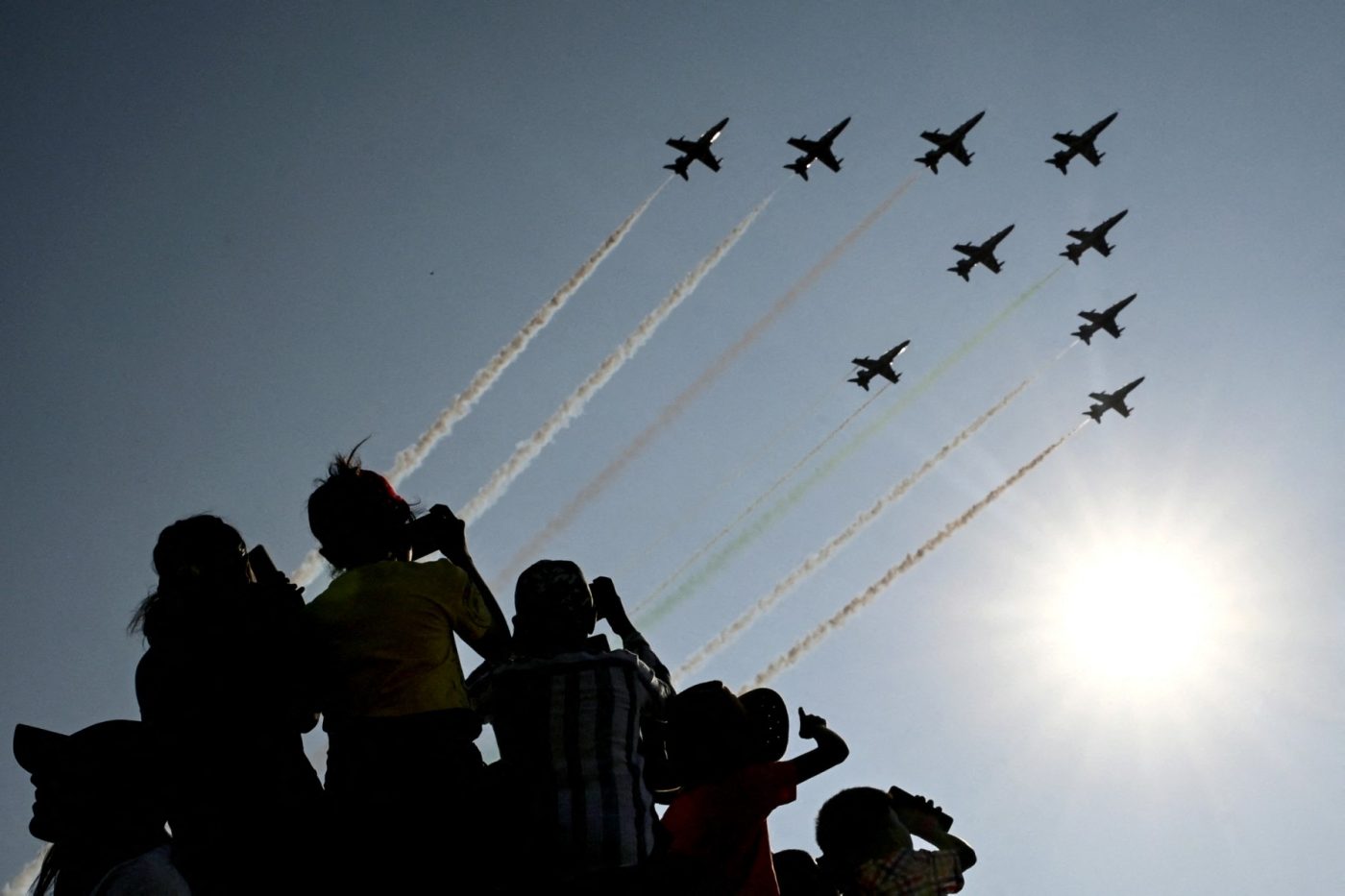Has the idea of theaterisation of Indian forces, now nearly five years old, gone on hold?
This question assumes significance given the reported resistance from the Indian Air Force (IAF) to the idea and the relative silence on the subject in recent months by India’s top political leadership.
Both Prime Minister Narendra Modi and Defence Minister Rajnath Singh are now emphasizing “jointness” rather than “theaterization,” although government officials explain the perceived shift in approach by stating that “jointness is the first step towards creating tri-theatre commands.”
At a seminar in Delhi on October 1, Defence Minister Rajnath Singh described the “jointness” among the three armed forces as an “operational necessity”, something, according to him, was a big success during the recent “Operation Sindoor” against Pakistan.
“Jointness has become a fundamental requirement for our national security and operational effectiveness today. While each of our services possesses the capacity to respond independently, the interconnected nature of land, sea, air, space, and cyberspace makes collaborative strength the true guarantor of victory,” Singh said.
He added that the tri-services coordination during Operation Sindoor produced a unified, real-time operational picture. “It empowered commanders to take timely decisions, enhanced situational awareness, and reduced the risk of fratricide. This living example of jointness delivering decisive results must become the benchmark for all future operations”.
Similarly, Prime Minister Modi, while addressing the recent Combined Commanders’ Conference in Kolkata (September 15 to 17), had underlined the importance of “jointness and integration”.
It may be noted that when Modi created the post of the Chief of Defence Staff (CDS) in 2020 as a part of reformation in the higher echelon of the defence structure, the logical corollary was to restructure the armed forces into integrated theatre commands (ITCs).
Currently, India has a total of 19 commands: seven army commands (six operational), seven air force commands (five operational), three naval commands (two operational), and two joint commands. However, none of them are co-located, and their geographical zones of responsibility have little in common.
Initially, it was reported that the government was toying with the idea (though not announced officially) of having five commands: The Northern Command – along the border with China, from the Karakoram Pass in Ladakh to the last outpost Kibithu in Arunachal Pradesh; the Western Command will look after the border with Pakistan, from Indira Col on Saltoro Ridge in the Siachen Glacier region to the tip of Gujarat; the Peninsular Command by merging the Western and the Eastern Command of the Indian Navy; a full-fledged air defence command that will not only spearhead the country’s aerial attack but also be responsible for defending Indian airspace through multi-role fighters and anti-aircraft missiles; and the Command tasked with protecting the Indian Ocean and India’s Island territories as well as keeping the sea lanes free and open from any outside pressure.
But, of late, one is hearing of only three “theatre commands” — Maritime or Peninsular Command, China Front Command based in Lucknow, and the Jaipur-based Command for Pakistan contingencies, each to be headed by a 4-star rank officer, who, in turn, will report directly to the Defence Minister.
It is speculated that the Army, Air Force, and Navy will each head a separate command, and hence each of the services will be satisfied.
In essence, two reasons are cited in favour of the creation of theatre commands. At a time when the national economy has too many demands to meet, there has to be a tightening of the belt by the three forces.
Secondly, tightening the belt must be done in a manner that does not compromise the combat capabilities of the forces. And that, in turn, will be possible when all the assets belonging to all the services in a given theatre are marshalled together.
For instance, in a given situation, the assets of the Indian Air Force can be combined with those of the Army Aviation Wing and the Navy’s fighter aircraft and helicopters.
The argument here is that in the event of a war or threat to the nation if there is one theatre commander, he will be competent enough to take a decision speedily (speed being the essence in fighting future wars that are going to be short and intense) as he has all the assets laid in front of him which he can utilise to achieve a particular goal.
There will be no need for the Army to request support from the Air Force or Navy, and vice versa. The Theatre Commander will be empowered to marshal any asset, be it naval, air, or land, as per the requirements of the operation.
In other words, each “theatre command’ will be responsible for a geographically defined area of operations. It would have a single military commander controlling all war-fighting assets of the three armed forces, including planes, helicopters, guns, tanks, equipment, ships, missiles, and manpower.
Each theatre command will, thus, have units of the Army, the Navy, and the Air Force, and all of them will work as a single entity looking after security challenges in a specified geographical territory.
The theatrisation plan has been fully supported by the Army and Navy. But the IAF continues to have serious reservations.
Like his predecessors, the present Air Chief, Air Chief Marshal A. P. Singh, has openly expressed his reservations about the implementation of the theaterization plan in haste. Instead, he has proposed setting up a joint planning and coordination centre in Delhi, comprising top military brass, to ensure tri-service synergy.
The IAF is said to be against splitting its limited aerial assets across multiple theatre commands, which it thinks could risk reducing its strategic flexibility. In its view, modern air power, unlike land or maritime forces, can be repositioned quickly to deliver strategic surprise, while also supporting multiple fronts as the situation demands.
The IAF states that centralized control (at the service level) and the quick redeployment of aircraft enabled it to sustain tempo across contingencies, contributing to the success of Operation Sindoor. Given this perspective of the IAF, theaterisation is not just unnecessary but potentially disruptive, creating layers of bureaucracy and limited resources at a time when speed and concentration of force are vital.
No wonder that at this recent address at the Army War College, Mhow, Air Chief Singh said that creating a new structure while disrupting everything is not a very good idea at this point in time. He was emphatic that joint planning and coordination worked very well during Operation Sindoor.
“I personally feel that having a joint planning and coordination centre in Delhi is what is required,” he said, suggesting that it should be kept under the Chiefs of Staff Committee’s direction that can be issued jointly.
The Chief of Air Staff also stated that India should not be inspired by any other country, such as the U.S., in establishing theatre commands.
“Everybody has their own requirements. We need to think about what we need there, and then only we should go about it. Otherwise, we will go wrong,” Singh said. “We should not just come under any pressure and say we have to implement it now. Somehow, we have to do it. It should not be done this way. I think we can stand our ground and discuss things,” he said.

“I feel having joint planning and coordination at the apex level is what is required. If directions go from it, things will work out. We don’t actually need another structure at the lower level,” Singh added.
Is what the Air Chief is saying, “joint coordination” the same as “jointness” that the Indian Defence Minister is emphasising? Purists among the strategic analysts do not think so. Jointness differs from joint operations, which are practiced during wars or war-like situations by every country.
In a true sense, jointness has four aspects: doctrinal, organisational, educational (training), and operational. In India, there is no common military doctrine; the respective forces have their own, resulting in tactical doctrines at best.
There is no jointness as each service has its own way in matters of training, equipment, procurement, and logistics. Even the Indian Ministry of Defence is far from being an integrated one, with civilian bureaucrats dominating decision-making, whether financial or operational.
Though the CDS is now the Secretary of the newly created Department of Military Affairs (DMA) in the Ministry of Defence (MoD), it is really strange that a four-star General like him is equated with a Secretary to the Government of India, whereas as per the protocol, a four-star General (or equivalent) is supposed to be on par with the Cabinet Secretary, the country’s No. 1 civil servant.
The CDS is not even the commander of all the country’s armed forces; he is on par with the three service chiefs in military status. He is not even the principal military adviser to provide impartial advice to the political leadership.
Be that as it may, the IAF’s reservations about the theaterization seem to be being taken more seriously than before. And that is largely due to its recent performance. In India’s actions against Pakistan in the last few years, first in 2019 through strikes at Balakot and now during Operation Sindoor, it was the IAF that led the show.
In popular perceptions, the IAF is the “service of choice” for achieving strategic paralysis of enemy forces deep inside their own country, thus becoming a symbol of decisive and technology-driven power projection. And that, in turn, seems to have enhanced the IAF’s leverage in any planning towards establishing theatre commands by retaining its existing institutional position.
Here, many consider that IAF Chief Singh, like his predecessor, makes sense when he says that the idea of theaterization is influenced by foreign examples, particularly the American one, which are not suited to India.
The point made here is that theatre commands may suit the American troops, who have a global presence, but they cannot be applied to India, whose military is primarily meant for protecting and defending the country’s borders.
It may be noted that the American theater commands, a result of the famous Goldwater-Nichols Act of 1986, were said to be prompted by a lack of service cooperation leading to failure in the 1980 Iran hostage mission and a poorly coordinated invasion of Grenada in 1983.
Every theatre commander, leading forces from all the services, reports directly to the President / Secretary of Defense through the Joint Chief of Staff. But the latter has only an advisory role. The respective service chiefs in the U.S. play only supporting roles in the recruitment and management of their forces.
However, after 40 years with the Goldwater-Nichols Act, serious questions are now being raised about its efficacy. China’s military growth, Russia’s invasion of Ukraine, North Korea’s and Iran’s pursuit of nuclear weapons, and Iran’s support of terrorism are said to have reflected “critical gaps in America’s military to deter assaults on U.S. vital interests”.
Secondly, ongoing problems with an ever-increasing U.S. defense budget, characterized by longer timelines to field new equipment in smaller numbers, have exposed issues in the defense acquisition system, which Goldwater-Nichols did not resolve; in fact, critics say, these problems have worsened over the last four decades.
Before Goldwater-Nichols, the individuals responsible for making these hard decisions were mainly the chiefs of staff of the individual services. Chiefs were well-suited to make them because they were personally accountable for both short- and long-term outcomes. They were charged with both commanding ongoing military operations and advocating in Congress for the equipment their service would need in future wars.
The Goldwater-Nichols Act removed the service chiefs from this role. However, it has been observed that theatre commanders have not been able to think beyond their regional needs; they lack an overall long-term perspective.
As a result, there are now demands by the strategic elites in the U.S. to restore the Service Chiefs to the chain of command and reduce bureaucratic inefficiencies.
This development in America could have been very good news for the Indian Air Force, strengthening its case against the idea of theatre commands in India.
- Author and veteran journalist Prakash Nanda is Chairman of the Editorial Board of the EurAsian Times and has been commenting on politics, foreign policy, and strategic affairs for nearly three decades. He is a former National Fellow of the Indian Council for Historical Research and a recipient of the Seoul Peace Prize Scholarship.
- CONTACT: prakash.nanda (at) hotmail.com




